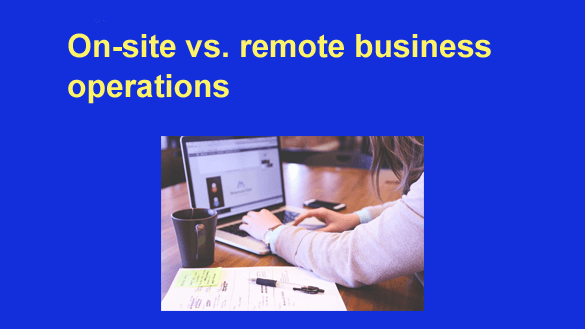 Running a business means you’re constantly faced with making decisions related to your company. Some of those will revolve around work processes and clients, while others will be aimed at your employees.
Running a business means you’re constantly faced with making decisions related to your company. Some of those will revolve around work processes and clients, while others will be aimed at your employees.
The second part is very important because the employees are the driving force of any company, so technically, they’re the ones who bring and keep clients and make profits.
In the past several years, remote work has become quite popular, and more and more companies have begun to adopt the idea. Like with most things in the world, there are pros and cons, so today, we’ll compare on-site and remote business operations. This should help you decide which is the best approach for your company.
On-Site Business Operations
This is the old-school model, where your employees come into the office and do all their work there. Although it’s not the most modern approach, many companies still rely on it despite its outdatedness in today’s world.
Advantages of On-Site Business Operations
While it may seem from a modern perspective that an on-site business model isn’t a great idea, there are some advantages to it. Having all employees in a single location means they’ll be in an environment promoting direct communication and collaboration. In-person meetings often result in a more creative environment, which helps a business remain successful.
Working from an office means there is a routine involved, which should help some people focus. Each employee knows they need to give their best at work, which is another advantage of this approach.
Resource access is another advantage of an on-site approach. This can be crucial when it comes to having physical access to resources. Sure, most things are digital these days, but there are situations when an employee will need a document or item only available in the office.
Disadvantages of On-Site Business Operations
At first glance, on-site working seems like a flawless plan, but there are some drawbacks you should be aware of. The first one is limited access to a talent pool. With this approach, your options are limited to local employees, ones who will be close enough to travel to work daily.
The most important aspect of the on-site business option is finding the right commercial property. Whether you plan on renting or buying the place, you’ll need to consider the financial aspect of this approach. In addition, you should also keep in mind that you’ll have monthly expenses to take care of. Primarily, these include maintenance and utilities, but there are others as well.
Remote Business Operations
The more modern approach to running a business is allowing your employees to work remotely. There are a lot of advantages to this approach, which is evident from its rise in popularity. With that said, it’s not perfect, so you should expect to see some drawbacks.
Advantages of Remote Business Operations
One of the most common advantages business owners mention when it comes to remote work is the cost savings. Unlike with the previous approach, here, you won’t have to think about a physical office, internet connection, computers, etc. In a worst-case scenario where you still need someone to come into the office, you’re saving a bit because it’s only a part of the team.
Speaking of teams, another crucial advantage of remote work is having access to a larger talent pool. You don’t have to think worldwide about this, but you are flexible enough to hire someone from a different state. This means you can hire people who match your criteria well and ensure your business runs as smoothly as possible. To be fair, this shouldn’t prevent you from considering hiring people from other countries.
Disadvantages of Remote Business Operations
Remote work has fewer disadvantages, but that doesn’t mean it’s the perfect model. The most common ones business owners notice are communication barriers and distractions. While employees working remotely is advantageous, the lack of face-to-face contact can sometimes make communication difficult. Also, while many remain professional and committed to their roles, the chances of distractions while working from home or a coffee shop are increased.
It also means employees can work on their computers from home or wherever they decide to be at the moment. While it’s feasible for some positions, others still require physical touch. You may encounter a situation where some employees won’t be overly happy, making it difficult. Employees in a position that requires them to be physically present are aware of that, but this still opens up the possibility of communication issues between both groups.
The business landscape is constantly evolving, bringing in new trends. One of the hotter topics these days is the duel between on-site and remote working business models. Both are good and bad, depending on which way you look at them. With multiple pros and cons on both sides, it’s up to you to decide which one works best for your company.